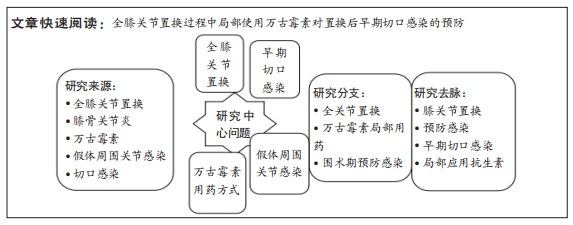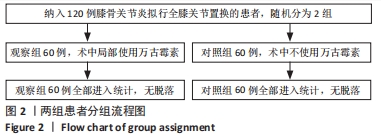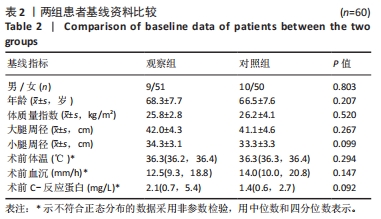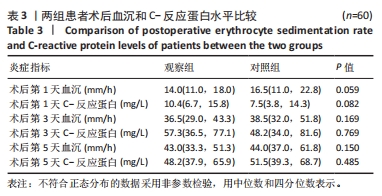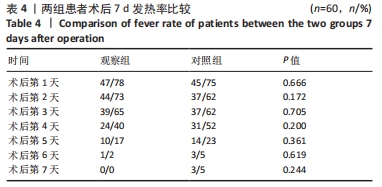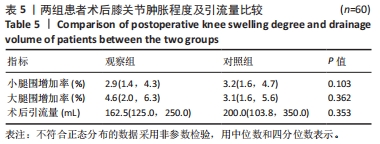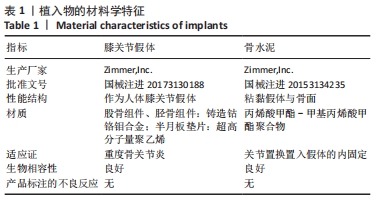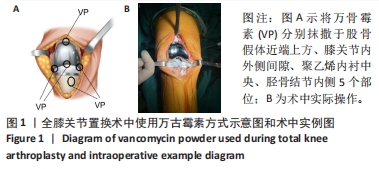[1] HAWKER GA, BOHM E, DUNBAR MJ, et al. The Effect of Patient Age and Surgical Appropriateness and Their Influence on Surgeon Recommendations for Primary TKA: A Cross-Sectional Study of 2,037 Patients. J Bone Joint Surg Am. 2022;104(8): 700-708.
[2] DOWSEY MM, BROWN WA, COCHRANE A, et al. Effect of Bariatric Surgery on Risk of Complications After Total Knee Arthroplasty: A Randomized Clinical Trial. JAMA Netw Open. 2022;5(4):e226722.
[3] RAJPUT V, MEEK R, HADDAD FS. Periprosthetic joint infection: what next? Bone Joint J. 2022;104-B(11):1193-1195.
[4] KHEIR MM, TAN TL, AZBOY I, et al. Vancomycin Prophylaxis for Total Joint Arthroplasty: Incorrectly Dosed and Has a Higher Rate of Periprosthetic Infection Than Cefazolin. Clin Orthop Relat Res. 2017;475(7):1767-1774.
[5] JONES R, QUARTUCCIO KS, STERN JL, et al. Antibiotic Stewardship Interventions Improve Choice of Antibiotic Prophylaxis in Total Joint Arthroplasty in Patients with Reported Penicillin Allergies. Clin Orthop Relat Res. 2021;479(7):1484-1494.
[6] LI M, LYU C, FANG Y, et al. Characteristics and risk factors of fever after total joint arthroplasty: a single-center retrospective study. BMC Musculoskelet Disord. 2022;23(1):979.
[7] LU X, JIN J, LIN J, et al. Course of fever and potential infection after total joint replacement. Knee Surg Sports Traumatol Arthrosc. 2015;23(6):1870-1876.
[8] KOLZ JM, RAINER WG, WYLES CC, et al. Lymphedema: A Significant Risk Factor for Infection and Implant Failure After Total Knee Arthroplasty. J Am Acad Orthop Surg. 2020;28(23):996-1002.
[9] DATTILO J, GITTINGS D, SLOAN M, et al. ‘Hot Joints’ infection protocol reduces unnecessary post-operative re-admissions following total hip and knee arthroplasty. Bone Joint J. 2017;99-B(12):1603-1610.
[10] UVODICH ME, DUGDALE EM, OSMON DR, et al. The effectiveness of laboratory tests to predict early postoperative periprosthetic infection after total knee arthroplasty. Bone Joint J. 2021;103-B(6 Supple A):177-184.
[11] CASENAZ A, PIROTH L, LABATTUT L, et al. Epidemiology and antibiotic resistance of prosthetic joint infections according to time of occurrence, a 10-year study. J Infect. 2022;85(5):492-498.
[12] FROSCHEN FS, RANDAU TM, FRANZ A, et al. Microbiological Trends and Antibiotic Susceptibility Patterns in Patients with Periprosthetic Joint Infection of the Hip or Knee over 6 Years. Antibiotics (Basel). 2022;11(9):1244.
[13] BUCHALTER DB, NDUAGUBA A, TEO GM, et al. Cefazolin remains the linchpin for preventing acute periprosthetic joint infection following primary total knee arthroplasty. Bone Jt Open. 2022;3(1):35-41.
[14] SHAHI A, PARVIZI J. Prevention of Periprosthetic Joint Infection. Arch Bone Jt Surg. 2015;3(2):72-81.
[15] URISH KL, DEMUTH PW, KWAN BW, et al. Antibiotic-tolerant Staphylococcus aureus Biofilm Persists on Arthroplasty Materials. Clin Orthop Relat Res. 2016; 474(7):1649-1656.
[16] RAVI S, ZHU M, LUEY C, et al. Antibiotic resistance in early periprosthetic joint infection. ANZ J Surg. 2016;86(12):1014-1018.
[17] VILLA JM, PANNU TS, RIESGO AM, et al. Dual Antibiotic Prophylaxis in Total Knee Arthroplasty: Where Do We Stand? J Knee Surg. 2020;33(2):100-105.
[18] LANE MK, KEENEY JA. Dual Antibiotic Prophylaxis in Primary Total Knee Arthroplasty-No Benefit for Extremely Obese Patients. J Knee Surg. 2022;35(11): 1209-1213.
[19] 汪萧和, 王志文, 陆鸣, 等. 两种止血带使用方式对150例全膝关节置换术患者失血量和术后康复影响的前瞻性随机对照研究[J]. 中华骨与关节外科杂志,2020,13(9): 736-740.
[20] 吴晓飞. 发热诊断的临床思路与急诊处理[J]. 中华全科医学,2021,19(12): 1989-1990.
[21] 李程,ANDREJ T. 人工关节置换术后假体周围感染的临床诊断[J]. 中华关节外科杂志(电子版),2019,13(6):715-723.
[22] SPRINGER BD. The Diagnosis of Periprosthetic Joint Infection. J Arthroplasty. 2015;30(6):908-911.
[23] YOUNG SW, ZHANG M, FREEMAN JT, et al. Higher cefazolin concentrations with intraosseous regional prophylaxis in TKA. Clin Orthop Relat Res. 2013;471(1):244-249.
[24] PENG Z, LIN X, KUANG X, et al. The application of topical vancomycin powder for the prevention of surgical site infections in primary total hip and knee arthroplasty: A meta-analysis. Orthop Traumatol Surg Res. 2021;107(4):102741.
[25] SLIEPEN J, CORRIGAN RA, DUDAREVA M, et al. Does the Use of Local Antibiotics Affect Clinical Outcome of Patients with Fracture-Related Infection? Antibiotics (Basel). 2022;11(10):1330.
[26] LEE SH, TAI CL, CHEN SY, et al. Elution and Mechanical Strength of Vancomycin-Loaded Bone Cement: In Vitro Study of the Influence of Brand Combination. PLoS One. 2016;11(11):e166545.
[27] TAILAITI A, SHANG J, SHAN S, et al. Effect of intrawound vancomycin application in spinal surgery on the incidence of surgical site infection: a meta-analysis. Ther Clin Risk Manag. 2018;14:2149-2159.
[28] BOKHARI R, YOU E, ZEILER FA, et al. Effect of Intrawound Vancomycin on Surgical Site Infections in Nonspinal Neurosurgical Procedures: A Systematic Review and Meta-Analysis. World Neurosurg. 2019;123:409-417.
[29] DEVIN CJ, CHOTAI S, MCGIRT MJ, et al. Intrawound Vancomycin Decreases the Risk of Surgical Site Infection After Posterior Spine Surgery: A Multicenter Analysis. Spine (Phila Pa 1976). 2018;43(1):65-71.
[30] YAVUZ IA, OKEN OF, YILDIRIM AO, et al. No effect of vancomycin powder to prevent infection in primary total knee arthroplasty: a retrospective review of 976 cases. Knee Surg Sports Traumatol Arthrosc. 2020;28(9):3055-3060.
[31] HANADA M, NISHIKINO S, HOTTA K, et al. Intrawound vancomycin powder increases post-operative wound complications and does not decrease periprosthetic joint infection in primary total and unicompartmental knee arthroplasties. Knee Surg Sport Tr A. 2019;27(7):2322-2327.
[32] XU X, ZHANG X, ZHANG Y, et al. Role of intra-wound powdered vancomycin in primary total knee arthroplasty. Orthop Traumatol Surg Res. 2020;106(3):417-420.
[33] PROBASCO WV, CEFALU CJ, LEE R, et al. Prevalence of idiopathically elevated ESR and CRP in patients undergoing primary total knee arthroplasty as a function of body mass index. J Clin Orthop Trauma. 2020;11(Suppl 5):S722-S728.
[34] FELDMAN M, AZIZ B, KANG GN, et al. C-reactive protein and erythrocyte sedimentation rate discordance: frequency and causes in adults. Transl Res. 2013; 161(1):37-43.
[35] UVODICH ME, DUGDALE EM, OSMON DR, et al. The effectiveness of laboratory tests to predict early postoperative periprosthetic infection after total knee arthroplasty. Bone Joint J. 2021;103-B(6 Supple A):177-184.
[36] KAINTH MK, GIGLIOTTI F. Simultaneous testing of erythrocyte sedimentation rate and C-reactive protein: increased expenditure without demonstrable benefit. J Pediatr. 2014;165(3):625-627.
[37] MAGRO F, SOUSA P, MINISTRO P. C-reactive protein in Crohn’s disease: How informative is it? Expert Rev Gastroent. 2014;8(4):393-408.
[38] LEE SA, KANG S, YOON C, et al. Temporal Value of C-Reactive Protein and Erythrocyte Sedimentation Rate after Total Knee Arthroplasty in Patients with Elevated Preoperative C-Reactive Protein: A Matched-Pair Analysis. Indian J Orthop. 2019;53(3):437-441.
[39] ASCIONE T, BALATO G, BOCCIA G, et al. Predictive value of fever following arthroplasty in diagnosing an early infection. Infez Med. 2017;25(1):3-7.
[40] WEINBERG L, LI M, CHURILOV L, et al. Associations of fluid amount, type, and balance and acute kidney injury in patients undergoing major surgery. Anaesth Intensive Care. 2018;46(1):79-87.
[41] SHOHAT N, GOSWAMI K, TAN TL, et al. Fever and Erythema are Specific Findings in Detecting Infection Following Total Knee Arthroplasty. J Bone Jt Infect. 2019;4(2):92-98.
[42] ULGER F, PEHLIVANLAR KM, OZTURK CE, et al. Non-infectious Fever After Acute Spinal Cord Injury in the Intensive Care Unit. J Spinal Cord Med. 2019;42(3):310-317.
[43] MAYO BC, HAWS BE, BOHL DD, et al. Postoperative Fever Evaluation Following Lumbar Fusion Procedures. Neurospine. 2018;15(2):154-162.
[44] 付志强,夏长所,李志杰,等,全膝关节置换后早期夹闭引流管对失血量的影响[J]. 中国组织工程研究,2016,20(13):1852-1858.
[45] 王笑欢,郭凯,牛子健,等,万古霉素致非霍奇金淋巴瘤患儿免疫性溶血及凝血功能障碍分析[J]. 中华实用儿科临床杂志,2021,36(20):1568-1571.
[46] SZOTS K, PEDERSEN PU, HORDAM B, et al. Physical health problems experienced in the early postoperative recovery period following total knee replacement. Int J Orthop Trauma Nurs. 2015;19(1):36-44.
|
